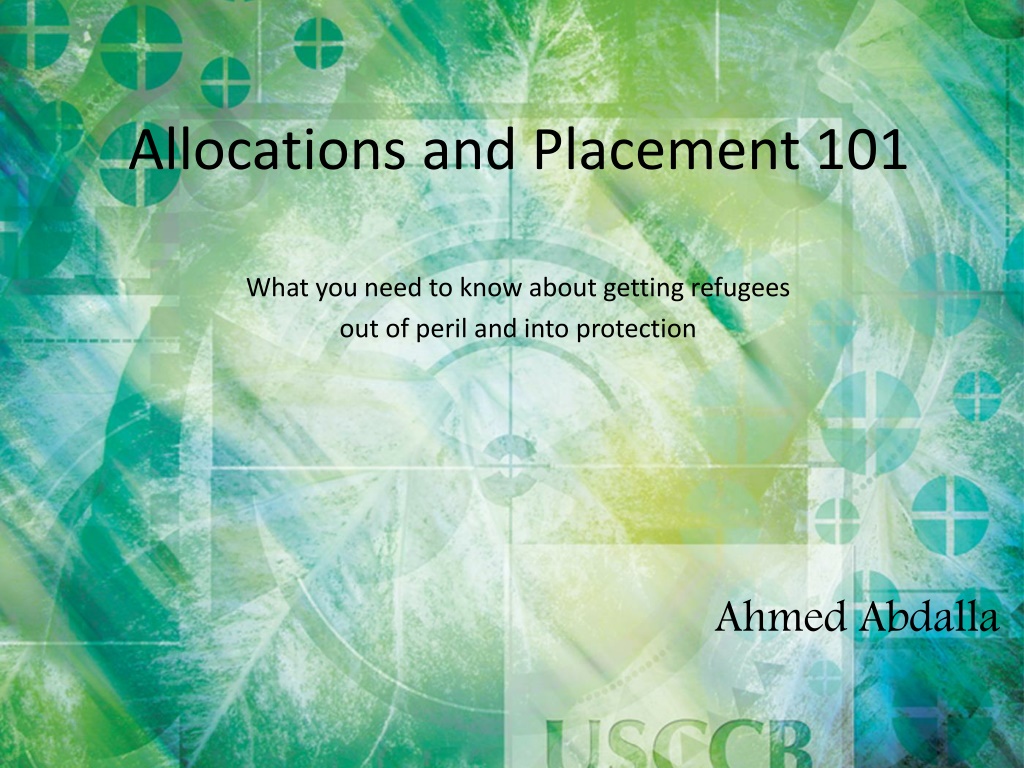Refugee Allocations and Placement: Ensuring Safety and Support
In the process of refugee allocations, various agencies and organizations come together each week to determine the placement of refugees based on different pools and criteria. Key topics covered include the allocation process, selection of cases, and the involvement of resettlement agencies. This comprehensive system aims to move refugees from danger to protection effectively.
Download Presentation

Please find below an Image/Link to download the presentation.
The content on the website is provided AS IS for your information and personal use only. It may not be sold, licensed, or shared on other websites without obtaining consent from the author. Download presentation by click this link. If you encounter any issues during the download, it is possible that the publisher has removed the file from their server.
E N D
Presentation Transcript
Allocations and Placement 101 What you need to know about getting refugees out of peril and into protection Ahmed Abdalla
What we will cover 1. What the allocation process looks like each week 2. How Medical and US Tie cases are chosen for the USCCB network 3. How No US Tie cases are selected and placed
Who attends allocations? CWS-Church World Service HIAS-Hebrew Immigrant Aid Society ECDC- Ethiopian Community Development Counsel IRC-International Rescue Committee LIRS-Lutheran Immigration and Refugee Service EMM (DFMS)- Episcopal Migration Ministries USCRI (IRSA)-U.S. Committee for Refugees and Immigrants WR-World Relief 9 Resettlement Agencies 2 RPC staff Allocations Meeting Room at the Refugee Processing Center (RPC) in Arlington, VA
Refugee Case Allocations Nine Resettlement agencies meet once a week to participate in distribution (allocation) of refugee cases. Refugee cases are allocated through three pools : - No U.S. Ties Medical Pool: cases with significant medical conditions not destined to a specific location. - No U.S. Ties Pool: Cases which
4 7 9 1 3 5 2 6 8
US Tie Pool Example US Tie Location
USCRI USCCB
Tampa-37 Venice 35
EXAMPLE OF WORKSHEET PREPARATION PRIOR TO ALLOCATIONS MEETING
EXAMPLE OF WORKSHEET PREPARATION PRIOR TO ALLOCATIONS MEETING
Placement Meetings: The tools we use 1. RP Placement Assessment 2. Current arrivals pipeline by diocese 3. Current projected capacity VS. arrivals 4. Anecdotal information/ TANF and RCA rates
SITE PLACEMENT CONSIDERATIONS Family Reunification (#1 priority) Ethnic communities present / Resettlement History Medical case services Housing cost and availability / Family Size Employment outcomes and local availability Education and Career path Community Based Resources Financial Assistance (TANF levels, etc) Specialized programs needed/available
Current Challenges in Placement Process Loss of Staffing Resources Severe medical conditions Community Push Back Employment Availability Housing
Just lost Karen speaker TX Now what???? At 125% of projected capacity Burmese Karen/Catholic PA/MO 3M1 No English Oldest child with Learning Disability IL Major Employer went bust PA Learning Disability OH No Issues presently




























